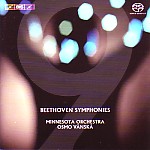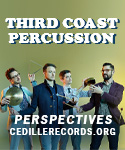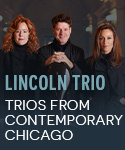All listeners and critics have their own criteria for what constitutes a great Beethoven Ninth, a work so rich in content and varied in performance history that there can’t be any one “right” way to present it. So when I say that this is a great Ninth, it’s meant in a very specific sense. From the purely technical point of view, Vänskä’s way with the score represents the best in modern performance practice, using the latest editions and taking into account the past several decades of historically informed pedagogy. But more importantly, Vänskä clearly understands that this factor alone, however well realized (and this performance is stunningly played and sung) isn’t enough. Mere technique must capture and project the emotional impact of the music, and it is in this respect above all that the interpretation achieves true excellence.
In some ways, the period-instrument movement has made it more difficult to do this music justice. The Ninth stands somewhat apart from the norms of its period, which is why it always has responded so well to the traditional large-scale, romantic approach. Most “authentic” performances reduce the symphony’s scale, offering in compensation a sort of generalized liveliness that minimizes the very real grandeur of the outer movements, trivializes the Adagio, and risks turning the piece into the crude musical equivalent of a tempest in a teapot. You can argue that this is no worse than the heavy patina of similarly generalized seriousness that typifies the Ninths that we’re used to, but aside from its familiarity, at least the traditional approach renders the big moments effectively and fulfills most listeners’ expectations in terms of sheer sonorous impressiveness.
It’s worth keeping this in mind, because what Vänskä achieves here is a Ninth built on a human scale, but one never lacking in depth of feeling. Indeed, one of the most rewarding signposts of the interpretation is that its relative intimacy brings with it an increase in the music’s expressive variety, the result being that the listener never feels short-changed, and the music unfolds with the necessary freshness and impact. It always sounds big-hearted. Take the first movement: this performance most closely resembles Munch’s nervy and exciting Boston recording for RCA. Exceptional instrumental clarity (check out the fugue in the development section) goes hand in hand with sharp accents to really make the music bite. The decision to drive inexorably forward means that the recapitulation, taken strictly in tempo, isn’t the cosmic event that others make of it, but as compensation Vänskä offers one of the most perfectly timed and shaped codas on disc. Note how his refusal to indulge in excessive ritards at the woodwind lead-in both enhances the music’s pathos and helps to shape the closing minutes as a single, massive musical arch. The bigness in this performance is cumulative, a function of linear progress through time rather than an emphasis on isolated events.
Another measure of “greatness” in a performance is purely comparative: Does this version do anything (that matters) better than anyone else? I would say so: This probably is the finest Scherzo on disc. Once again Vänskä achieves miracles of textural transparency, but more importantly the rhythm really bounces and the string articulation is something marvelous. The music never sounds merely dogged. Indeed, it acquires an all-too-rarely-heard dimension of Haydnesque humor, nowhere more so than when the solo timpani interjections in the movement’s second half, forte throughout in keeping with the latest scholarly reading, gleefully trip up the three-bar phrasing. Vänskä’s tempo for the childlike trio, always a point of contention, relates logically to the scherzo proper, and perfectly captures Beethoven’s evident conception of a Presto that still coveys a measure of relative relaxation. You simply won’t hear it done more splendidly, anywhere.
In the Adagio, the new, speedier approach gaining currency today prevents tedium from setting in but challenges the conductor to match the meditative intensity of the romantic tradition. Many period-instrument performances dash through the movement in about 12 minutes, making hash of the violin’s ornate later variation, and (oddly enough) chopping this lyrical music to bits. At a touch longer than 14 minutes, Vänskä finds a happy medium, neither rushed nor static, and he achieves the necessary feeling of sublime repose by careful observance of dynamics. Listen, at the very beginning, to the hushed strings alternating with the more expressive, vocal interjections of the winds–like islands in a vast sea of calm. Throughout the lengthy coda the music seems to hover weightlessly in mid-air, the warm strings illuminated by the glowing timbre of the woodwinds.
After an explosive opening, Vänskä heeds Beethoven’s injunction to take the finale’s initial recitative in tempo, but he ensures sufficient flexibility to let the music really speak. The instrumental “joy” variations build to a hugely exciting entry of the vocal solo, though bass Neal Davies’ declamation is choppier than I prefer. No Heldentenor, Daniel Norman’s light and easy timbre suits Vänskä’s bracing account of the march (“very quick,” as Beethoven directs) quite well. The two women are neither better nor worse than most, but here I have to confess that Beethoven’s solo vocal writing in this movement is so ungainly that I seldom downgrade any performance on that basis unless something truly appalling happens, which is never the case here. Indeed, soprano Helena Juntunen does quite well save for one somewhat screechy phrase just before the coda.
One thing is certain: the chorus sings magnificently throughout, and with such clarity of diction that you can practically transcribe the text of Schiller’s ode even if you don’t know German. As with the instrumental contribution, Vänskä gets all of his singers to communicate the sense of the music with remarkable immediacy, and even with swift basic tempos there’s plenty of weight at such places as the big tenuto on “vor Gott!” as well as in the choral fugue with its spectacular soprano climax. Happily, Vänskä refrains from rushing through the final “maestoso” apotheosis to Joy, so that the prestissimo windup caps the symphony naturally and spontaneously. It almost goes without saying that BIS’s sonics are state of the art, both in stereo and multichannel formats.
As I said at the beginning of this review, everyone will have their own idea of what makes a great Ninth, but I can assure you that the above description is true to the musical facts. Vänskä’s Minnesota Beethoven cycle is not yet complete. Still, there’s no question that this Ninth will crown the whole magnificently and set a very high standard for modern-instrument performances in the “new” Beethoven tradition. [9/22/2006]
































